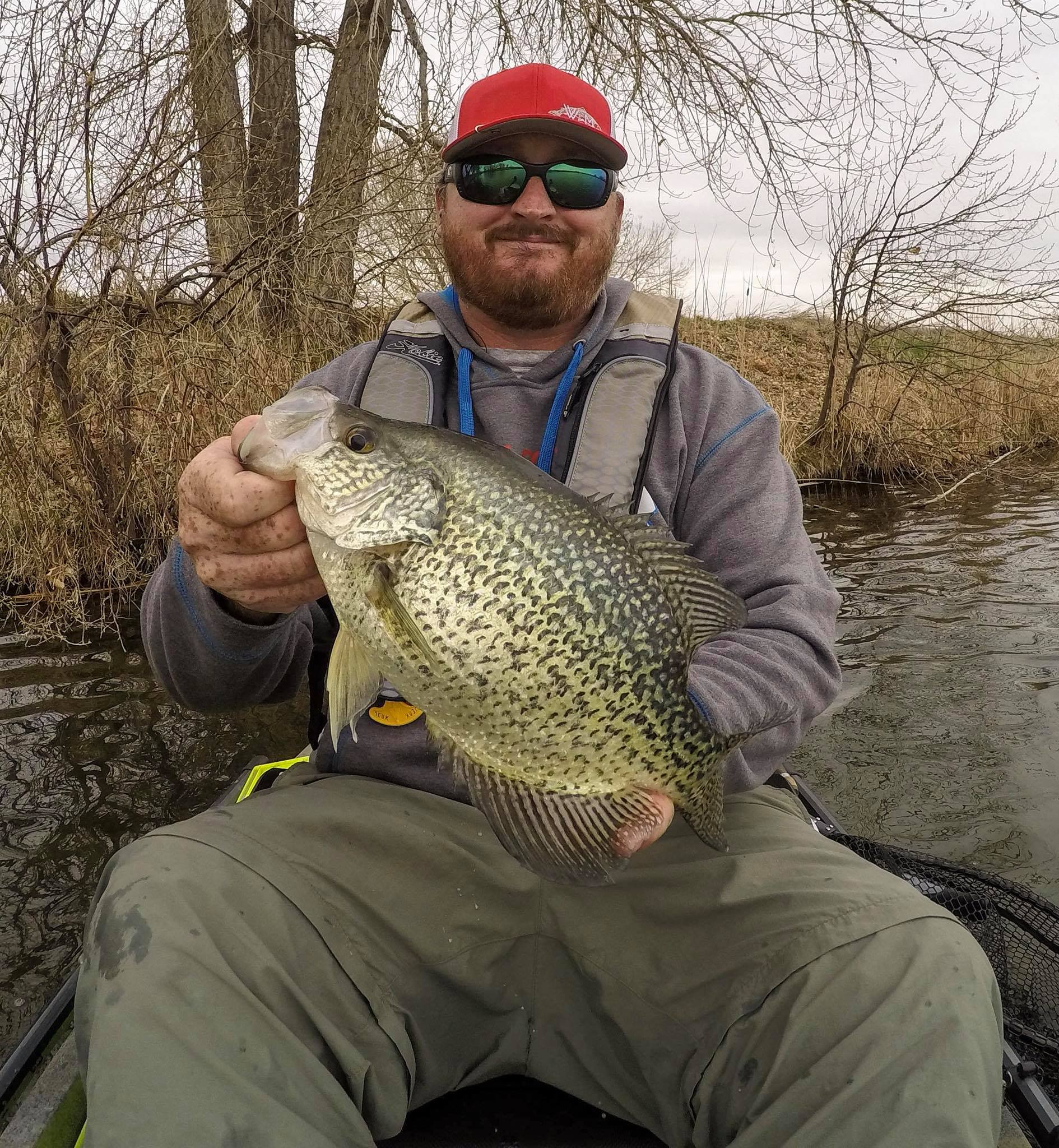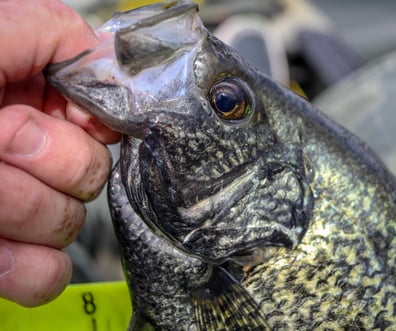
Fishing a drop shot rig is a multi-species hammer anglers can utilize to catch fish in various situations. In this blog, we'll go over how I stumbled across the effectiveness of a drop shot for several gamefish species in conditions not typically associated with fishing a drop shot!
Story Time:
Years back, fishing out of my kayak, I stumbled into a school of giant crappie. Now, I’d like to write that something spiffy about me using years of experience and know-how to locate the school of giant crappie, but truth be told, I snagged the dock they were hanging around. When I pedaled my kayak over to the dock to get my Texas-rigged craw back, I noticed crappie stacked around the dock pilings. When I say crappie ole buddy, I mean full-on slabs! The kind of crappie that are big enough that you start thinking about a replica mount instead of tossing them into the deep fryer.
Now the problem was all I had on me was bass gear. Two casting rods to be exact, one spooled up with heavy fluorocarbon for Texas-rigged craws and another spooled with heavy braid for hollow bodied frogs. I’d been fishing this old farm pond for years and had it pretty dialed in. I’d seen crappie before, but nothing like these slabs I stumbled onto by accident.
Like a little kid tearing through a cereal box for the prize, I was feverishly trying to find anything I could catch those slabs with. I couldn’t find anything that made sense. Sure, they were big enough to hit most of my bass tackle, but that didn’t mean they would. It wasn’t until I grabbed my drop shot box I felt like I had a shot.
It felt a little odd at first tying on Lazer Sharp drop shot hook on 15lb flouro, but it was the only option I had. After securing the drop shot hook on the fluoro with a palomar knot, I noticed the hook was facing down. If you want to cook with peanut oil when you’re drop shot fishing, you always want the hook point to be facing up. A neat trick an old fella taught me years ago was to run the tag end through the eyelet again and you can pop the knot through, which puts the hook right where it needs to be. Then I put a ¼ ounce drop shot weight a couple feet below the Lazer Sharp, right where the crappie were suspending on the dock pilings.
.png?width=236&name=Screenshot%20(23).png)
My first cast was awkward as could be, but with a 7ft medium heavy/fast action casting rod I was able to put the drop shot rig right next to the dock piling. I waited until the weight hit bottom, then started imparting action into the 4 inch finesse worm by wiggling my rod tip ever so slightly. The goal is to get some action out of the bait while it’s suspended, but you can’t get overzealous and move the weight forward. The juice with a drop shot is you can keep it where fish are feeding. It couldn’t have been a minute before my little finesse worm was trucked. I darn near ripped that crappie’s lips off. I couldn’t help it when I have that rod and reel in my hands I’m used to putting the wood to them!
To make a long story short, I slammed crappie off that dock and every other dock on that little farm pond. I caught a few that would stretch the tape past 15 inches which was awesome, but I couldn’t stop thinking about all the different scenarios I could utilize a drop shot rig. Sure, much like a lot of bass anglers, I’d been fishing a drop shot as a finesse presentation in clear water forever, but where else could it be effective.
Since snagging that dock, I’ve caught big rainbows drop-shotting leeches, pike drop-shotting soft plastic stick baits, walleye drop-shotting minnows, perch drop-shotting small swimbaits, and of course, loads and loads of bass drop-shotting a variety of baits.
A bait, a hook, and a weight. Simple. That’s a drop shot rig when you boil it down to the nitty-gritty. It is a super simple presentation that allows us to keep a life-like soft plastic dancing in the strike zone until it gets bit. If the fundamentals stay intact, why could an angler use a drop shot for everything from crappie to pike? We can. The only limitations most of us face when adding the drop shot rig to our multi-species arsenal are our imaginations.
For some reason, finesse presentations seem to conjure up misconceptions that expert-level technical expertise is needed to fish them effectively. Rest assured, you don’t need a Ph.D. in light line and clear water to set up or catch fish on a drop shot rig. Remember, it’s just a bait, a hook, and a weight. Sure, the hook and weight are specific to the drop shot, but that doesn’t change how simple the rig is.
How to rig a drop shot:
-Hook selection depends on several factors. I prefer to nose hook all my finesse worms on either a Lazer Sharp or Trokar drop shot hook to keep it simple. When I’m drop-shotting swimbaits, you can’t beat the new AXS Drop shot hooks also available in Lazer Sharp and Trokar.
Using a palomar knot, the hook should be facing upward. *If your hook is facing down after tying your palomar knot, run the tag in back through the eyelet and pop the knot through. It’ll pop that hook right in a jiffy.
-Make sure when you’re tying your palomar knot, you leave plenty of line to attach your drop shot weight. I like leaving more than I’m going to use and then clipping off excess line I don’t need. You can always snip off what you don’t need, but if you don’t leave yourself enough line you’ll have to re-tie.
-Let the fish tell you where they want your bait to be suspended. I’ve had days where that means it’s a few inches off the bottom, and days where I’ve almost had 3 feet between my drop shot hook and weight. When in doubt start in the 12-16 inch range and adjust as needed.
-Don’t tie on your drop shot weight! The reason we use drop shot weights and not casting sinkers is it the design allows anglers to get their hook back even when the weight gets stuck. It also allows anglers to change the depth between their weight and hook quickly. Thread your line through the eyelet on the drop shot weight and pull the line up to the pinch point.
How to fish a drop shot:
After casting to an area, you know or suspect fish are holding, let your rig sink to the bottom. After it hits the bottom reel up to where there’s just a tad of slack in your line. By moving your rod tip and working that slack ever so slightly, your bait below will start to dance. I like to keep my rod around the two o’clock position when I’m putting action into a drop shot rig. It’s comfortable and gives me plenty of room when it comes time to set the hook.
Less is often more when it comes to drop-shot fishing. This isn’t always the case, but it rings true often enough it’s worth mentioning. Most of the time, imparting a little action on the rod tip translates to more than enough movement on your drop shot rig down below. If you aren’t getting bit usually it’s because you’re overworking your bait. There are times where you want to shake the snot out of your drop shot like you’re all hopped up like you just slammed a pot of coffee, but generally speaking, less is more.
When to fish a drop shot:
I always have a drop shot rigged regardless of water temp or season, but it’s to fish areas where I know fish are concentrated. A drop shot is a smart missile not an atomic bomb. If your goal is covering a lot of water to find fish a drop shot isn’t the ticket. If you want to target specific pieces of structure, cover, or both where you know fish, the drop shot rig comes into play.
A drop shot rig flat out gets bit in a wide variety of conditions for most gamefish species! If you're new to fishing, don't be intimidated by drop-shot fishing. Remember, it's a simple rig anyone can learn and catch fish using: a bait, a hook, and a weight.
If you have any questions about rigging or fishing a drop shot rig, post them in the comment section below. We're here to help!

